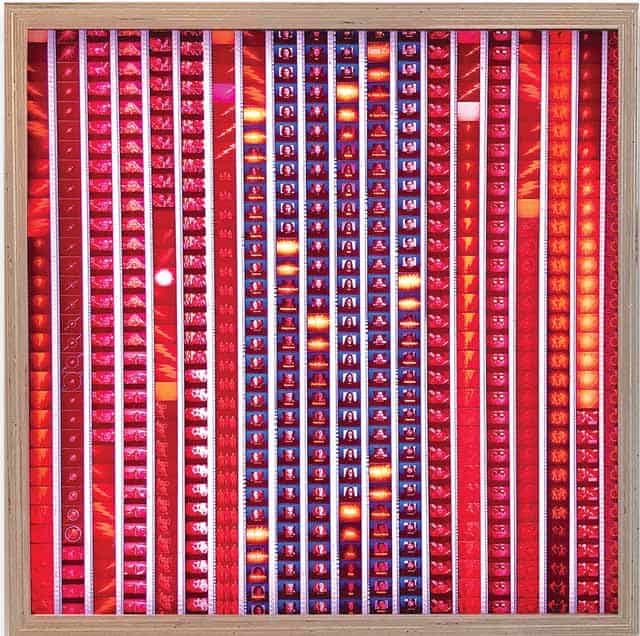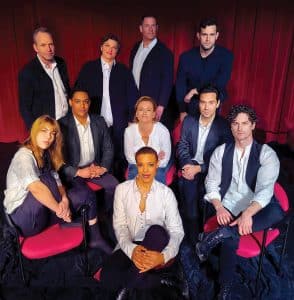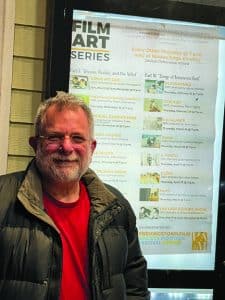by Rebecca M. Alvin
It might be hard to imagine today, but for Alan Strack, childhood meant watching lots of movies in actual movie theaters… Sometimes two or three movies a day even. Strack’s grandparents owned movie theaters, including one of the first drive-ins, and spending time with them in Oneonta, New York, meant a cinematic adventure few kids had then and virtually none have now.
While these theaters (like many) are long gone, the memories of a childhood immersed in everything cinema have made a permanent mark in the designer-turned-mixed-media-artist. Growing up in the 1980s his room was “wall-to-wall movie posters” and film paraphernalia was always around. “[My grandparents] had these lightboxes outside of the theater along the wall that would display what was coming down the pike so to speak,” he recalls. “I was always fascinated with movie posters and I think that was what sparked my initial interest in graphic design, because I started collecting the movie posters and I would find out that the movie poster itself was actually sometimes way more interesting than the film, somehow. Just this sort of notion that that was your first point of reference with a film, I think, especially more at that time than now, because I think now, obviously, kids are bombarded with everything before it actually comes out. But back then, the poster was the first thing you really saw. And you really only saw trailers for the most part at the theater.”

Strack, who admits to being something of a hoarder (in the delightfully eccentric sense, not the deeply problematic addicted sense) is now making use of some of the thousands of feet of movie trailer footage he inherited when his grandparents passed away in a series of constructions made out of 35mm movie film, LED lights, and plexiglas, which will be on display at the Schoolhouse Gallery in Provincetown as part of their exhibition 7 Projects for the Provincetown International Film Festival.
Strack had been living in Portland Oregon, working for Nike for many years as a designer, but moved to New York for his wife’s job. The work itself speaks of that special quality only the film material has. Ephemeral, chemical, even a little mysterious, motion picture film is distinct from its cousin, still photography. The strips of celluloid require the imaginative process of mentally recreating the motion one was meant to see in them when projected. Each frame just slightly altered from the one preceding it, the strip lives differently mounted as Strack has them than it does on the screen. And yet, they call to mind, with no small amount of nostalgia, the cinematic experience.
As a young adult, Strack did experiment with film, making a few films and trailers in college, which he likens to the Spike Jonze/Jackass style. He also studied photography, but says he “fell into graphic design and then kind of fell into a job right out of school from there.” It’s only very recently that all of these interests converged into this Lightreel series.
Strack’s cinephilia is the Generation X kind. It isn’t arthouse cinema or classical Hollywood that drive the movie-love. The pieces reflect these pop-cultural references with films like the 1980 version of Flash Gordon, Cry-Baby, and The Adventures of Priscilla, Queen of the Desert celebrated more than Casablanca, Citizen Kane, or La Dolce Vita.
“Growing up I was a big fan of the cult films and also I really liked John Hughes films,” he says, referring to the director of so many classic teen movies of the ‘80s, such as Sixteen Candles, The Breakfast Club, and of course Ferris Bueller’s Day Off.
Strack remembers growing up in the Midwest and identifying strongly with those films, one in particular. “I would say Ferris Bueller’s Day Off had a pretty big impact on me… I just really liked his philosophy. Not to make it sound deep, because it’s such a kind of a silly movie, but just the idea that really struck a chord with me, you know this idea that ‘life moves pretty fast. If you don’t stop to take a look around once in a while, you could miss it.’ I think that really hit a note with me and in high school, my nickname was Ferris because I may or may not have missed more than my fair share of school days,” he laughs.
He also recalls getting into some Bueller-esque situations, such as the time he used a chemistry assignment as a way to get into a Wisconsin brewery as a 16-year-old and freely spent the day there drinking unlimited beer with no questions asked.
Strack will have three pieces in this show, which also includes cinema-influenced works by Amy Arbus and Martha Posner, Faith Hubley, Kahn & Selesnick, Jefferson Hayman, and Joel Janowitz. It’s the perfect complement to Provincetown’s five-day festival of film worship.
Alan Strack’s work will be exhibited in 7 Projects for the Provincetown International Film Festival at the Schoolhouse Gallery, 494 Commercial St., Provincetown, June 12 – 17. For more information call 508.487.4800 or visit galleryschoolhouse.com.










